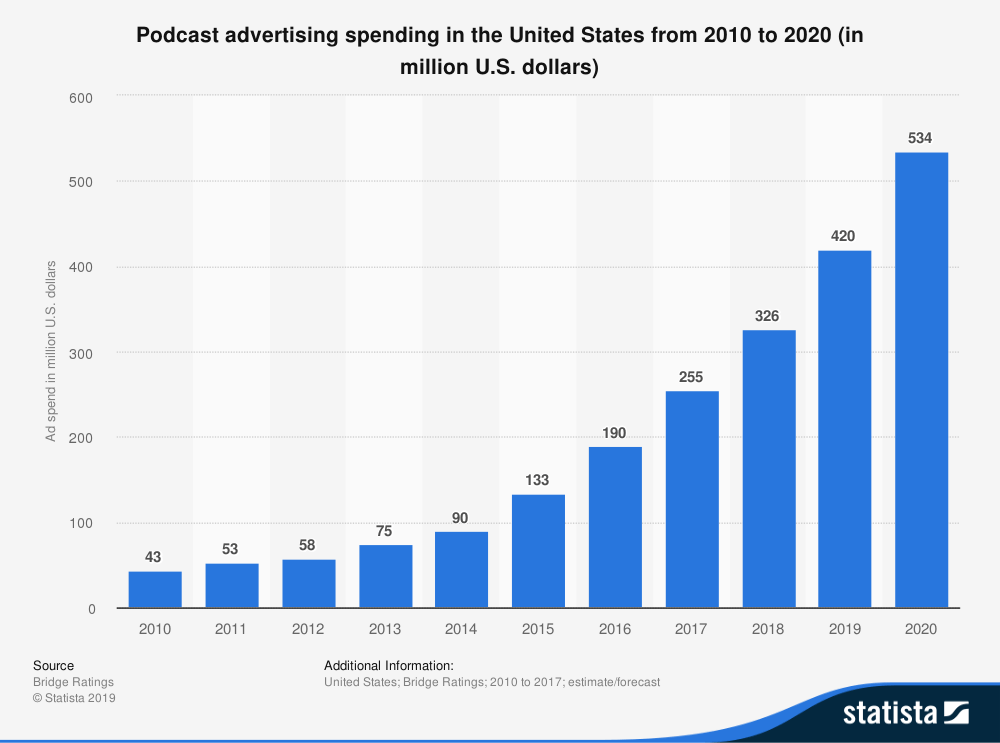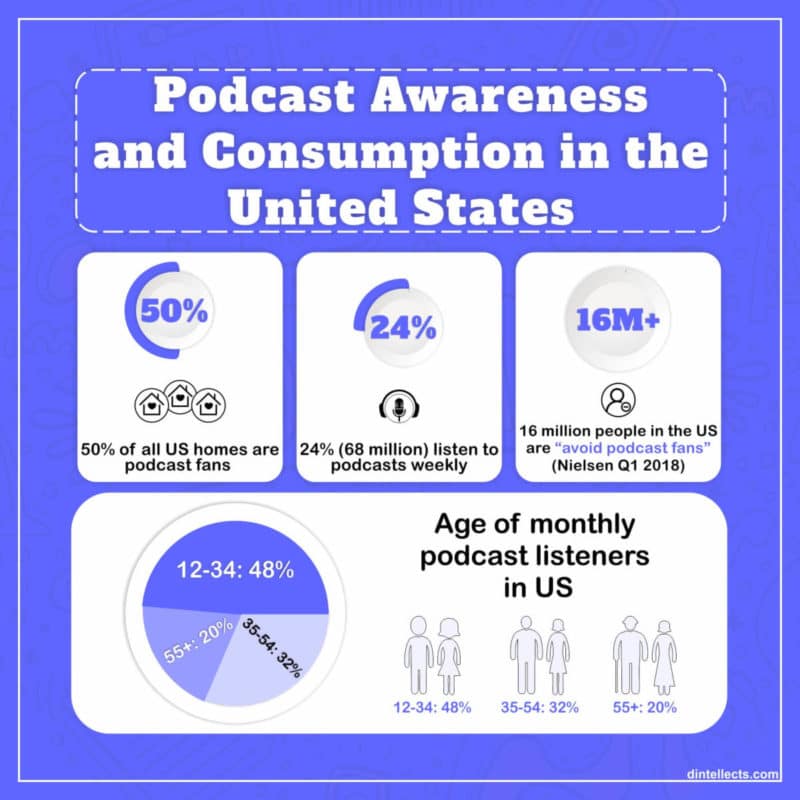You may have been flirting with starting a podcast for content marketing for a while now. “Figures don’t lie” and with podcasts that can’t be overemphasized. Statistics show that over 50% of homes in the US are fans of podcasts, which translates to 60 Million homes or so.
Before we go far, what is a podcast? This is a digital evolution in radio broadcasting where marketing content is kept in audio files and released episodically through internet syndication.
Podcasts help businesses communicate their brand proposition to a captive audience. We are an on-the-go culture, and thus, the demand for podcasting is rising. A forecast by Statista shows that the number of podcast fans will surpass the 160 million mark by 2020. Now, that should ring a bell to every marketer.
The Podcast helps you develop thought leadership for your business, and it’s a way of showcasing to the market that you are the go-to source of information.
Research by Edison Research.com shows that over 1/3 of Americans above the age of 12 years and 104 million are consuming podcasts over 75%, which is an equivalent of 212 million Americans above 12 years familiar with podcasts. Awareness and consumption continue to increase by the day.
That helps you shed any doubt that podcasting is one of the most popular marketing strategies in the world.

Having no excuse, it’s time you leave the shore and chat the waters.
But before we get to the gist of the matter, let’s briefly compare video to podcast marketing
A podcast is easy to make, you only need to have the audio gadgets and a mastery of the language of communication for your audience, and you’re good to go.
From the consumer perspective, a podcast is convenient for the followers to listen- they don’t have to stop what they’re doing to watch, they only need to switch on when driving, on treadmills, taking a walk or busy at work- such convenience is what people are looking for. On top of this, podcasts also can be one of the pillars of inbound marketing.
Following are the steps in making a podcast, buckle up!
Podcast planning stage
Have you ever wondered how to start a podcast that will keep your listeners glued and demand more? Then, you are in safe hands here; you will get all the right information that you need to start yours right away.
Though many podcasts sound like free flow, they have a script format that they follow.
For you to deliver a great podcast in the best conversational tone, then you need a well-scripted podcast template to follow. Scripts serve as guides that help you move smoothly through the show’s content.
#1 How do you write a podcast script?
The first thing is to take a bird’s eye view of your show. What is it that you need to make your content feel consistent for the listeners? This will make you aware of what is coming up in the show and ensure that your show sounds cohesive.
#2 It’s all about creating a momentum
Whether you are creating a short and a snappy show or long-form piece, you have to keep the topics flowing and your audience engaged. As a way of breaking up the conversation, tone, and pace, use guests in your show.
You can use interludes like music to transition between topics, otherwise called sweepers. That gives your listeners time to digest what they’ve heard before moving to the next bit of your show.
Ensure each episode has its themes, topics, and length so that you set them apart.
#3 The podcast structure
The material you deliver to your audience must be relevant, and that demands you research your topic. The language you use should be friendly and conversational. Keep off the temptation of using jargon; otherwise, you may lose your audience.
#4 First podcast segment
Your first Podcast must be done carefully and in a way that will leave your audience yearning for more. Deliver broad content that will appeal to all your entire audience.
You also need to have a grasp of the news and trends to capture the attention of your listeners.
#5 Subsequent podcast segments
Once you introduce yourself in the first Podcast and grab the attention, the next thing is to maintain and focus on more listeners. This can only be possible if you focus on specific areas that are of interest to your audience.
A standard segment should not be more than four paragraphs. If you can do two, the better.
#6 How do you introduce your Podcast?
Every of your Podcast episodes needs to be introduced – keep it short, some 10 seconds, and not more than 15. If you make it too long, it may be skipped through the skip setting in most podcast players.
Here, you introduce your co-host, if any, and give a brief preview of what the listeners expect to hear. If you have something juicy, give your audience a tip and spare some time at the end of the show- this keeps them glued to your content.
#7 How do you wrap up?
As you conclude your Podcast, you may want to give a recap of the topic and, most importantly, talk about exciting episodes. Be careful to include a call-to-action.
Stay Up-to-date
You have planned your Podcast with the relevant content that you want to deliver to your audience. You need to identify hot topics in your niche, research them, check out how competitors have done it, and come up with a unique presentation that will ‘wow’ your listener.
A perfect way of engaging with your audience is by introducing a subject that is already trending and relevant to your niche. What are the listener’s pain-points, and how have your competitors dealt with such?
You will identify the missing link and then try and address such- when done correctly; it could be your springboard to your marketing success.
Keep following the conversation on your social platform, even when not on air, to pick the trendy topics that your audience prefers and inform the content of your next episode. Where necessary, get an expert in the subject and let them address the issues- with such, you’re home and dry.
Create quality content
Once you have identified a topic for your next episode, do some detailed research on the subject and see how others have done. That will help you focus on quality content that adds value to the listener.
You don’t want to keep your audience regretting why they had to tune in to your Podcast. Look for unique and informative content that rightly addresses the needs of your audience.
Presenting half baked topics will only work against your efforts, and you could excite your followers and force them to seek solutions from your competitors- thus, you must be thorough.
How long should a podcast episode be?
The content you wish to present will determine the length of the Podcast. Many players in the podcast content field argue that a podcast episode should not go beyond 20 minutes.
However, it’ll depend on the content you have and the target audience. For instance, if you target the over 52% American middle class who commute to work or business, you may have to make it brief considering the time they have while on the bus or train.

Again, be consistent in your episodes. One subject should lead to another, and you have to handle each uniquely. The topic you introduce in an episode should be fully developed in the next one, and all should be focused on the bigger picture- giving solutions to your audience.
Again, avoid releasing too many episodes in a short span. Plan your timing carefully and ensure that you have sufficiently dealt with the previous before you introduce a subject.
Give your listeners time to engage through your social platforms. From their responses and reactions, you will know how better to handle your next episode and where to improve in your packaging.
Podcast formats
Once you have pictured how you want your show to be, it is easy to choose the perfect format to bring value to your audience.
Following are some of the accessible podcast format
#1 Interview shows
Here, you have the show hosted by one or two people, and you have guests in every episode. The audience can learn from different experts in a specific subject or a variety of disciplines. This type of show works best when all the quests are connecting well. You have one person/ the frontman/woman leading other experts in an episode.
The lead singer syndrome hosted by Shane Told of Silverstein is an excellent example of an interview show where listeners join at a minimum fee of $6 a month for digital-only to $25 a month for the Platinum club. It’s a show that brings about backstage conversations of music fans to live. It’s now a popular show, with immersed listeners who give suggestions on what they want to hear- so incredible.
The Laptop lifestyle created by the digital creative Teichmiller is another interview show worth noting. It’s meant for adventure seekers, virtual entrepreneurs, and millennials on the go. It’s a weekly program where Alexis discusses the valleys and peaks of the laptop lifestyle.
#2 The conversational podcasts
Here, you have a chat of two people discussing a given subject. These shows have multiple hosts, and every time they are focused on a topic or reviews. Your listeners will feel connected to the panelists and thus more useful than narrating a story.
‘Fantasy footballers’ is one of the best football fantasy shows with episodes every Monday. It’s hosted by three Mike, Jason Moore, and Andy Holloway. The trio breaks down fantasy football with strong opinions and astute analysis and unmatched winning advice.
#3 Educational shows
Educational podcasts shows have multiple hosts and are more structured. The episodes feature a specific takeaway, and listeners tune in to learn about the subject at hand.
A good example here is The Femtrepreneur Show produced by Mariah Coz and Megan Minns. It features new episodes every week, and it’s a learning experience on how to create, run, and sell online courses.
Most entrepreneurs use these to present lessons to their audience. You need to get a topic related to your niche and make it a theme, bring in an expert where necessary- it’s more of a learning experience.
#4 Solo-casts
These are featured monologues that the creator feels essential. It relies on the creator’s experience on a particular subject and can be anything from advice-based content to comedy. You are the source of knowledge, and you can be bringing guests once in a while for added interest.
A perfect example here is the Creative pep talk, a show that helps artists in building a thriving career. It is hosted by Andy J. Pizza who serves up interviews and monologues and oftentimes invites industry powerhouses, making the show a very interesting one.
#5 True story Podcasts
These are podcasts that tell stories about what is happening in the world around us. They could report on daily news or some in-depth investigation like a documentary. You can choose a story and tell it over different episodes or even create an account for every episode. That will depend on your level of creativity and the subject that you are handling.
Here, you have to make it as captivating as possible by bringing in live interviews, narration, and some interludes to make the story interesting.
Think of a show like 99% invisible, a big ideas podcast created by Roman Mars, and its main objective is to celebrate everyday design and architecture with captivating stories of exceptional designers.
How do you market your Podcast so that it trends?
It’s now clear that podcasts will be here, and big brands are willing to use significant budgets on Podcasts. Rumor has it that Spotify will be spending a whopping $100 Million to secure Joe Rogan’s experience. Now, that’s a big shot and tells you Podcasts are the way to go.
To get more subscribers, this is how to market your Podcast
#1 Interviewing people with engaged audiences
Many podcasts are built on the interview-style model. When you interview somebody who has an audience, it’s a perfect way of putting your content in front of new faces- an ingenious way of growing your subscribers.
Interviewing someone with an excellent following will mean you have an already engaged audience listening to your Podcast.
#2 Timely episodes
Creating timely episodes will make people want to listen to it right away. This helps them stay up to speed with what’s happening.
#3 Make video snippets
The video snippets act like appetizers to your Podcast. Sharing it on Facebook, Instagram, Twitter, and other social media accounts is an excellent way of sensitizing listeners so that they get super excited for the real episode.
#4 Promote your episodes on social media
You can begin a conversation around your episode months before. That works well on your social platforms. For instance, on Instagram stories, you can start a story that touches on your Podcast so that your audience gets excited about it and can look forward.
Podcast best practices by industry experts
You may want to ask; why start a podcast when the industry is so saturated? But a serious creator knows how to navigate and get your voice heard, whether through a blog or video blog. However, before you venture into Podcast, follow these industry best practices.
#1 Take your time
A podcast is not something you do and throws it on air the following day. Creating quality content takes time. You must take time to prep the content, and edit before you allow it for consumption. Statistics show that podcast listeners are young people of ages 12-24 who make 40% of the US’s total population. Most of these are educated and well exposed, which means you have to be very creative to attract them. Never do a podcast in a rash, take time, do several tests before you release your episode.
#2 Be consistent
You must keep your audience engaged all through. If your episodes are exciting, you will have many referrals and thus build a strong client base. Create a schedule and stick to it. It can be monthly, weekly, or even fortnightly.
#3 Invest in quality microphones
The equipment makes a huge difference. Listeners are keen on the quality of your Podcast, and any mistake on the audio quality may keep off many.
#4 Choose topics you’re passionate about
If you talk about a topic you don’t love, be sure it will flop. Get a subject that you can flow with, and this will spark interest among the listeners. Your listeners will be drawn to your Podcast, depending on the energy you exude.
Conclusion
Podcasting is an effective and cost-efficient marketing strategy that helps in creating brand awareness and enhances your catchment. Anyone would want to listen to some audio that adds value to their business or life.
Follow the outlined steps in this article, and then you have your dream come true.





2 Comments